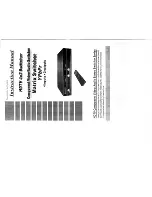
Switch/shutter actuator 8/4gang 16A RMD
75318003
Switch/shutter actuator 16/8gang 16A
RMD
75310002
Technical
Documentation
© Berker GmbH & Co KG 2007
Version: 04.04.2007
Part 5
(Subject to prior change)
75310002.doc
Seite: 81 / 174
Reference travel
After ETS programming (physical address, application program, partial download) or after actuator supply
voltage failure (bus and mains voltage) all current position data are unknown. Before the actuator can
approach new positions after bus and mains voltage return or after programming, the positioning system
must at first be calibrated. The positioning system can be calibrated by carrying out a reference travel.
A reference travel is the time required for a travel movement into the upper end position increased by 20 %
and additionally by the parameterized travelling time extension (cf. Fig. 29). A reference travel is not
retriggerable.
Reference travels can be executed by the following commands...
–
an uninterrupted long-time travel (including also a terminated safety travel) into the upper end position
activated via the corresponding communication object,
–
an approach of the 0 % position,
–
a manually controlled movement into the upper end position.
Shutter
Shutter
Awning
Venting louver
0 %
100 %
0 %
100 %
0 %
100 %
0 %
100 %
100%
0%
100%
0%
Slats
reference travel
Typ 1
Typ 2
reference travel
reference travel
reference travel
reference travel
Fig. 29: Reference travel
In the event of slat positioning via the corresponding communication objects after bus and mains voltage
return or after programming, a slat reference movement becomes necessary if the blind has not been
moved beforehand in the up or down directions for at least the parameterized slat moving time. During a
slat reference movement, the actuator always moves the slats for the parameterized slat moving time into
the completely open position (0 %) and then to the desired position. The slat position is also considered as
calibrated when the blind has been moved by a long-time command in the up or down direction during at
least the parameterized slat moving time.
A terminated reference travel of the blind will also calibrate the slat position.
If the reference travel is interrupted for instance by a short-time operation, the position is still unknown as
before.
A long-time travel into the lower end position activated via the corresponding communication object also
calibrates the reference position.
















































